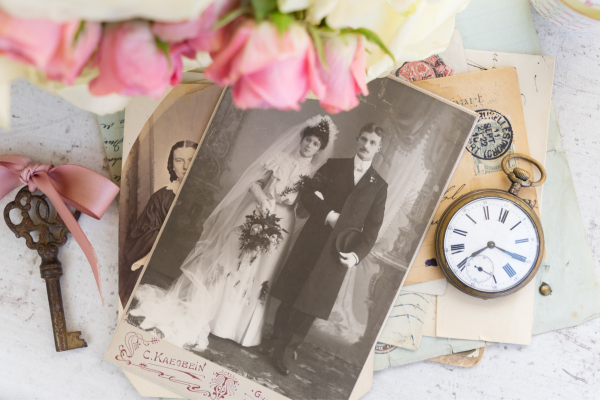Every day, people seek different ways to hold tight to the epochal moments in their life. From blurry photos of historic landmarks to souvenirs of life-changing travel to family recipes stained with sticky fingerprints, each of these items contributes to your and your family’s story. But how can this story grow and live on for generations?
Think about the book set you inherited from your bibliophile grandmother or the coins your dad adds to his late father’s collection or the recipes your aunt recreates from generations past that taste like the land they were brought from. All of these instances are a form of preservation—a way to continue a legacy and tell your story.
Preservation, in and of itself, inspires a new life. What does preservation mean to you and how can you use it to continue your family’s legacy? Let’s explore this idea together.
Find intentional ways to tell your story.
Family heirlooms are precious objects that can bring so much value and meaning to your loved ones, but they can also be cluttered when not approached with care.
The items you choose to pass on should reflect the things most important to your family. For some, their parent’s chipped china isn’t representative of their story whereas for others, that china may have been brought from another country and/or signifies their shared love of food.
Far too often, heirlooms become lost or forgotten, tucked away in an attic corner, covered in cobwebs, or marked with decay. Instead of letting your family documents fall prey to moths, be intentional about the items you wish to keep and how to preserve them over time.
Perhaps your great-great grandfather’s compass acts as decor in your office or your parent’s wedding album sits next to yours on the bookshelf or your great aunt’s furniture chest adds vintage-flare to your living room as a coffee table. Finding intentional ways to display, use, and experience these treasures makes them part of your daily life and keeps them close to your heart.
Make a plan for your heirlooms.
Be specific on how you want your items to be passed down, especially for valuable items like jewelry or collectors sets. Your great-grandmother’s ring, for example, may have traditionally been passed to the eldest daughter; what does that mean for your family of all sons?
The bottom line is that you want your heirlooms to have a purpose and intention behind them so they don’t get lost in the shuffle or shoved in an attic corner.
Preserve precious artifacts with care.
Once you know (or have) your heirlooms, how can you preserve them? Remember, there are several ways to document or maintain these items. Below are a few ideas to consider.
- Make the most of digital storage
- You can scan old photos, letters, newspaper clippings, awards, and other memorabilia and maintain it in digital format. This way, you can share precious family memories with many relatives and can have better access to them.
- Take the time to clearly label the photos with names, dates, places, times, and any other contextual information.
- Create photo albums
- Perhaps you love the feeling of real paper and books in your hands. If so, make a photo album. This is a great way to display and add to your family story throughout the years. Using a protective sleeve will also help preserve the integrity of the photos over time.
- Make a timeline with artifacts, marriage documents, letters, etc. to piece together your family story.
- Preserve, add to, and pass down recipe books.
- Food is often an important part of families’ lives. Many people can remember sitting at the table talking, eating, and laughing with each other. You can use the art of food to preserve history, heritage, and legacy.
- Learn and write your family story
- Collect primary source material like diaries and letters and write your version of your family history/story.
- Pass down artisan goods
- This could be anything from pottery to woodworking to needlepoint. Many older pieces of furniture, for example, could bring a personal, warm, and vintage feel to your space.
Remember, you want your family items to remain in good condition as long as possible. To do that, consider the following:
- Store photos and other documents in archival quality folders and sleeves.
- Properly protect fabric (cloth, silk, cotton, etc.) in a temperature and humidity-controlled space (a.k.a not your attic). They should also be in protective, acid-free containers.
- Wrap fragile items.
- Insure precious heirloom jewelry.
Involve your family in the process.
Heirlooms are certainly a family matter, so be sure to include your family in this process. Make the photo album with your sister, invite your granddaughter into the kitchen as you’re making dinner, answer your grandson’s questions when he asks what you’re writing—these are small but poignant ways to involve your family with your heirlooms. Isn’t family what these precious items are all about, anyway? You want to develop an attachment together so that those items are always emblems of remembrance, inspiring memories of your time together.
These items can become the heart of your family. Something as simple as handwriting can become a valuable memory like the way your mom’s cursive swirled to dot an “i” or cross a “t”. Those effortless marks will bring you back to the day she wrote those notes for you, and you for your loved ones.
Your legacy extends far beyond dollars and cents. It’s about how you live your life and capturing the beautiful moments that turn into memories. You can preserve and protect those memories for generations to come by being intentional about experiencing, protecting, and preserving family heirlooms.
Have you considered how your precious treasures will make their way to the next generation? These heirlooms are exactly the kind of thing you would document in your will. How else can your estate plan best represent your legacy? Let’s talk more about it together.
